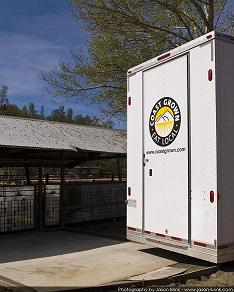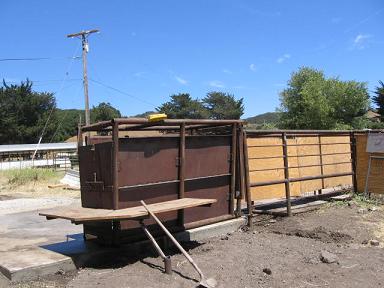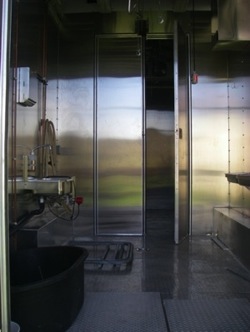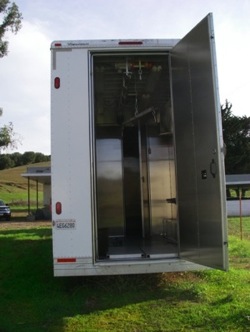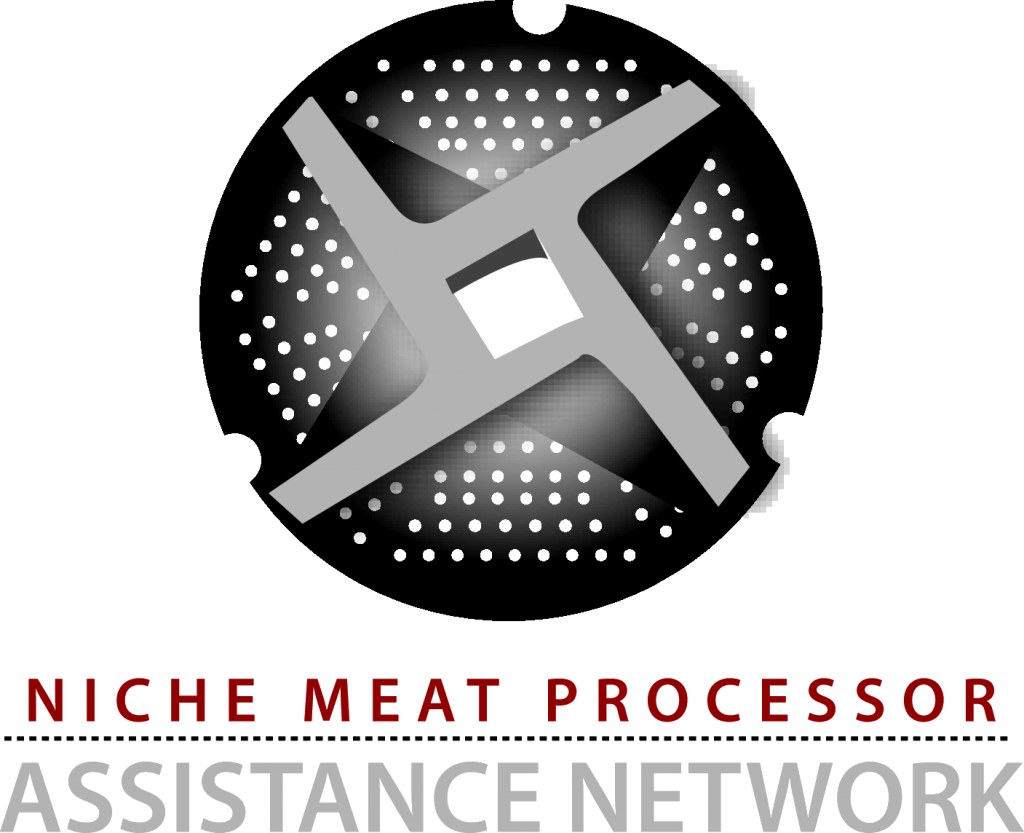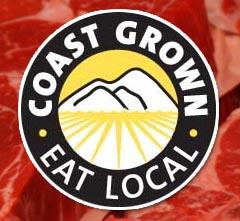 Central Coast Ag Co-op website
Central Coast Ag Co-op website
Update: Fall 2012
As of September 2011, the Central Coast Ag Cooperative MHU is BACK in operation, slaughtering under USDA inspection at least 2 days/week. The MHU is still owned by the co-op but is leased and operated by J & R Meats, a small butcher shop in Paso Robles, which also does the hanging, cutting, and packaging. Site requirements (including a concrete pad, a solid wall as a visual/sound barrier, and an all-metal stun chute) have restricted MSU operations to a few ranches so far, but other ranches can bring their animals to those sites. We checked back in on this unit in the Fall of 2012, and it is still in operation, processing about 5 to 7 beef/week at 2 different ranch sites.
Basic information
Capacity per day: 5 to 6 beef (or 10 lambs/goats/hogs)
Hours/day of operation: Up to 12, incl. travel/off-loading
Days/week: 2 to 3
Weeks/year: On demand, year-round.
Species: beef (pigs & sheep soon)
Services: slaughter only
Square feet: 208
#/type of employees: 3: managing butcher, ass’t butcher, truck driver
Annual revenues: projecting $100,000
Price of services: prices vary
Operational costs: $800+ per day without overtime, more for locations >50 mi. distant
Retail on-site: no
Wholesale: no
Inspection: USDA
Certified organic: no
Certification agency: n/a
Custom work: All is custom (fee for service). Can do custom-exempt slaughter any day, 3 beef minimum
Source verification on label: done by fabricator; all meat labeled with ranch name
The market opportunity
The Central Coast region of California has a vibrant local food system, with a strong consumer base and marketing infrastructure developed in large part by the “Buy Fresh, Buy Local” public education program created by Central Coast Ag Network (trade name “Central Coast Grown”), a regional non-profit.
By 2007, regional demand for locally raised meat had become large and loud enough to warrant the significant financial and human resources needed to bring that meat from ranch to table – in particular, figuring out processing.
Ranchers in the region were willing to supply the meat, but the closest USDA-inspected slaughter facility (California has no state meat inspection program) was many hours’ drive away. In addition, the closest processing facility had capacity and quality problems.
The people/organizations involved
- George Work, a Monterey County rancher who first conceived of the project;
- Central Coast Homegrown Meat Alliance, formed by George, Rex Swan, and other ranchers in the region;
- Sam Farr, Congressman from CA’s 17th district, strong supporter of local, sustainable agriculture;
- Monterey County Agricultural & Historical Land Conservancy, owned the unit;
- Deb Garrison, former coordinator of Central Coast Ag Network (trade name “Central Coast Grown”), a non-profit 501c3 established in 2004 primarily to create demand for regionally produced food;
- Central Coast Agricultural Cooperative, incorporated in August ’08, trade name “Coast Grown.” Members must be located within a 100 mile radius: Santa Barbara, San Luis Obispo, and southern Monterey counties. As of summer ’09, the co-op had 7 ranchers.
- J&R Meats, a butcher shop in Paso Robles
History and development
The mobile processing unit itself has been around since 2002. Monterey County rancher George Work started a “farm-stay” program on his ranch, then found he couldn’t legally serve meat from his ranch to his guests. The closest USDA-inspected slaughter plant was hundreds of miles away, making it extremely cost prohibitive to haul a few animals at a time.
George found out that the first USDA-inspected mobile processing unit was just getting up & running in Washington state: he did his homework and told his Congressman, Sam Farr, about it. Without much warning, Farr was able to redirect $138,750 in unspent federal Economic Development funds to build an MPU for Central California. George quickly hired Bruce Dunlop, who built the WA unit, and he and Farr arranged for the funding to be run through the Monterey County Agricultural and Historical Land Conservancy (now Ag Land Trust), which would own the unit to be leased by the ranchers. Bruce delivered the new MPU in 2002. George and other ranchers formed the Central Coast Homegrown Meat Alliance, to get the unit up and running under USDA inspection.
At that point, the project stalled. Though they now had a mobile unit, the Alliance had not aligned themselves with a USDA processing establishment. The closest USDA cut and wrap facility – an essential partner for a mobile slaughter unit –was close by but didn’t have a good reputation for quality. A couple of ranchers tried to sort out the regulatory requirements – from USDA, the state, the regional water quality board, and the county – but they became overwhelmed and frustrated by what seemed insurmountable obstacles and little or no support for their vision. It also didn’t help that few of the ranchers had had a chance to develop markets for their meat. After an energetic but ultimately fruitless push in 2005, the Alliance parked the mobile unit at the Work Ranch, and there it sat.
Two years later, enter Deb Garrison, a local food entrepreneur and the coordinator of Central Coast Ag Network, a non-profit educational organization for local foods. She and others had started the “Buy Fresh Buy Local” campaign in the Central Coast area in 2004. The project included public events where farmers and ranchers teamed with chefs “to cook a fabulous meal” showcasing local foods. “We built the demand. That helped tremendously.”
Deb explains, “It was easy for me to get fruits and vegetables into the local foodshed, but not meat.” Demand for local meat was growing, and ranchers were willing to supply it, but they had no way to get it USDA processed without driving hundreds of miles for inspected slaughter, then taking it to a local USDA inspected fabricator that was already maxxed out on capacity. “That’s when I got interested in making that unit go again.”
Deb had been working with George Work for quite some time with Central Coast Ag Network. “He said, gosh, Deb, you’re so passionate about this local food initiative… I have an abattoir sitting in my yard, not being used, it was so difficult, we lost interest… would you be interested in getting it going?”
In September of 2007, Deb partnered with the San Luis Obispo Farm Bureau and Central Coast Resource Conservation and Development Council and won a USDA Rural Business Enterprise Grant to do three things. First, the market research – with chefs, local grocery chains, and consumers – proved and described the demand for local meats, hence the need for the mobile unit. “We really did our homework.” Second, developing the supply side by creating the Central Coast Agricultural Cooperative and the website for product sales. Third, research on how to get the mobile unit up & running.
Because the abattoir was purchased with federal funds, the organizational shuffle was complex: first, the Central Coast Homegrown Meat Alliance dissolved, which meant it had to donate its assets to another nonprofit. Its key asset was the lease on the mobile unit, which was owned by the Monterey Agricultural and Historical Land Conservancy. When the Alliance dissolved, the Land Conservancy – at a big media event – donated the unit to the new Central Coast Agricultural Cooperative.
The actual transfer was more straightforward: “I went to George’s ranch, charged up the battery, and drove it away.”
From September 2007 to September 2008, they researched compliance issues for both the unit and all ranch sites, wrote the unit’s operational standards, HACCP plan, and Sanitation Standard Operating Procedures, and drew up the site plan.
Funding sources
- The funding to build the mobile unit came from the federal Economic Development Department; the funds had been returned by the original grantee, and Congressman Sam Farr managed to redirect it for this project;
- A USDA Rural Business Enterprise Grant paid for the market research, formation of the Central Coast cooperative including writing a business plan, and regulatory compliance research for the mobile unit;
- The Co-op is currently operating on a bank loan and is working hard to boost product sales to bring in operating capital.
Business plan – How it works
Deb Garrison wrote the business plan for the unit and the cooperative as a whole. She has been a business plan consultant for years, writing plans for agricultural operations.
Starting out, the MPU – which, for marketing reasons, they call an “MHU,” H = Harvest – slaughters two days per week. Coast Grown (CG), without its own cut & wrap, uses a local fabricator. His shop is closed by the time the slaughter day ends, so the carcasses are stored overnight in coolers at the ranches, and are off-loaded at the fabricator the next day. They can do this two-day cycle – slaughter one day, offload the next & park – twice a week. If the fabricator decides to open on Saturdays (possible), they’ll have another cycle.
Carcasses are hung for 14-21 days, then cut and packaged. The producer pays the fabricator directly. CG picks up the packaged meat, to store in freezers at the CG storage facility in Oceana, for just-in-time sales. A couple of ranchers store their own meat on the ranch, to sell there or at farmer’s markets.
Website sales – www.coastgrown.com – began in mid-June. When Deb gets a website order, her system sends an invoice to the rancher with order specifics, and the rancher must then get the meat to the CG storage facility two days before delivery, which CG handles. The cooperative is also planning on starting neighborhood meat buying clubs.
The co-op never owns the meat – the marketing is provided as a service to the co-op members – but retains 15% of the sale price to cover costs.
As of summer ’09, sales are limited to the tri-counties, to keep delivery miles manageable. Deb hopes to start national sales soon, via FedEx.
Ranchers control how they sell, and all sell differently: some will sell you one steak, others have order minimums or only sell 50 and 25 lb packages. CCG requires a minimum order of $150 for delivery, though shoppers can buy less and pick it up at the CCG Oceana facility. Some producers sell through their own websites, at farmers’ markets, and to restaurants.
Deciphering regulations and complying
This process began in 2002 and was never straightforward, largely because this is the first inspected mobile slaughter unit in California, which has its own USDA district. It was a huge challenge to figure out which regulatory agencies have jurisdiction and over what, and what the specific requirements are.
George Work and the Alliance had started down this path, and when Deb Garrison took over, she started wading through his records to find names of people he’d already talked to, such as the state’s meat and poultry inspection agency (despite the agency’s name, CA doesn’t have a state inspection program per se). She called two people at USDA’s Alameda District to verify information in Alliance records and found that much of the information they’d originally been given was wrong, even down to the forms. “Just finding the right application form was a challenge … even the front line inspectors didn’t have the form number right.”
After six months of confusion, mixed signals, and very little help, Deb finally heard – and not even from the USDA inspectors themselves – about FSIS’s Small/Very Small Plant Guide: Applying for a Federal Grant of Inspection for Meat and Poultry Establishments. Finally, she had real information. “Everyone has to start with that guide.”
[NMPAN has developed an online version of this guide.]
Waste water disposal was a challenge. The animals had to be slaughtered on cement pads on the farm. Then the butchers would rinse the blood off the cement pad. The county required that the unit have a set of guidelines for how to dispose of that rinse water, and that the Natural Resource Conservation Service write the guidelines which then had to be approved by the California Regional Water Quality Control Board. Jeff Rodriguez, with NRCS in Morro Bay, helped navigate this labyrinth and wrote the guidelines. The county then waived the permit & monitoring requirements.
The offal is the larger challenge. Unlike Washington state, California is not willing to let offal be composted on farm. But Deb found, through her local Resource Conservation District, the CA Integrated Waste Management Code of Regulations for dealing with offal on farm, which state that in CA, you can neither bury any animal products on your property nor compost them. Deb thought she saw an opening: “It doesn’t say anything about not putting it on the ground and letting wildlife eat it, as long as it’s not near a water source. So let’s just leave it here as if it the cow had died on the farm. I will admit, I was in a gray area.” After a couple of weeks, they were shut down by the state’s Meat and Poultry Inspection Agency (MPIA), which required them to take the offal to a rendering plant.
CCAC hopes the state will someday accept on-ranch offal composting. In the meantime, the unit has to carry the offal back to the cut & wrap, in 44 gallon Rubbermaid tubs, to be picked up by the local rendering company. The fee, ~$6/animal, is fairly cheap, but the whole process requires extra staff time, and more weight/wear on the trailer.
Ranch slaughter sites have also been challenging, and under the current requirements, a rancher must spend ~$5000 for infrastructure, including a covered cement slab, an ante-mortem inspection pen with shade for waiting animals, a suspect pen, an slip proof alley way that leads to a welded metal stun box where the animal is held still during slaughter, and a door off that box for the animal to fall out afterward, onto the slab.
The cost of compliance with these extensive requirements – which go far beyond what USDA has required for MSUs in other states – has meant that only a few of the larger, wealthier ranchers are using the MPU. With a $150/head kill fee, and the cost of building a ranch site, small growers in the region who originally wanted to finish and direct market a few animals from their cow-calf herd may not be able to make on-their-ranch slaughter pencil out. However, they can bring their animals to meet the MHU at ranches that DO have approved sites.
Plant design
The MPU was built by Bruce Dunlop, based on the same design as the Island Grown Farmers Cooperative MPU in Washington.
Big Glitches and how they were solved
The first, at the start, was that the MPU had to be tied to a cut & wrap facility. When George Work and Rex Swan started out, they just focused on the unit itself. But not every cut and wrap facility has a docking station to receive carcasses from a mobile unit.
The second glitch was the county requirements for wastewater management and needing NRCS to write the guidelines and the Regional Water Quality Board to approve them to get a permit waiver from the counties.
The third has been the seemingly excessive USDA requirements – at least before the recent turnaround.
Deb had trouble finding all the FSIS requirements, until she found the above-mentioned FSIS guide. While there were plenty of directives and categories on the FSIS website, they were not presented in a useable way for new plants: “a person who has never been in the business before would have no idea. And most people starting up these mobile units have NOT been in this business.”
Even when they had their temporary grant of inspection, getting an actual USDA inspector was a challenge. They were assigned a tour of duty inspector in the beginning, who had only limited hours for them.
And, as noted above, the USDA district for California has taken a long time to warm up to MHUs and has been more restrictive than other districts about ranch site requirements. This has meant that not many ranches can host the MHU.
Fourth, maintenance fees were huge, because the MHU broke down quite often. It was only the second such unit built, and it sat idle for seven years. However, it is running more smoothly in its latest iteration.
Finally, and most importantly, the unit has struggled to stay busy enough to cash flow. Handing off operations to a cut & wrap facility (rather than operating it as a co-op and partnering with a fixed facility for cut & wrap) may go a long way to solving this problem (e.g. not having to support an entirely separate operations staff).
Equipment required
- The MPU set-up and equipment are standard (except the offal tubs).
- The ranch sites must have a concrete pad, stun box, several pens, and a visual/sound barrier (solid wall).
Staff needed, how they were found and trained, and what they cost
The MHU is operated by J & R Meats, a butcher shop run by a father-son team. They lease it from CCAC, which has a board of directors but no paid staff working with the MHU. No pay data are currently available.
Financial sustainability plan
Originally the co-op hoped that website meat sales would allow the MHU to be financially sustainable on its own. That did not happen, and the MHU had to suspend operations. However, the new lease arrangement with J&R Meats, coupled with outside financial backing for that company, may prove financially sustainable this time around.
Keeping cash flowing and people busy during seasonal slow times
They continue to work on this, but now the MHU is one part of a larger meat business that has other ways to stay busy year-round.
Markets accessed
Ranchers are selling their meat direct to individual consumers as well as to restaurants and institutions. This is wine country, with many upper-end restaurants with the space to hang a quarter to cut however they want, so there is some potential for restaurants and wineries to buy sides and quarters.

